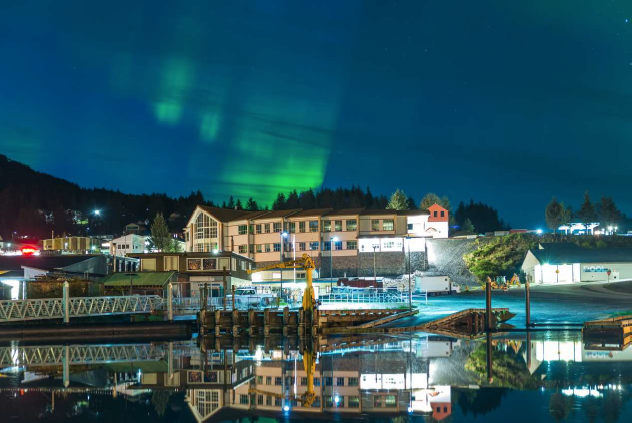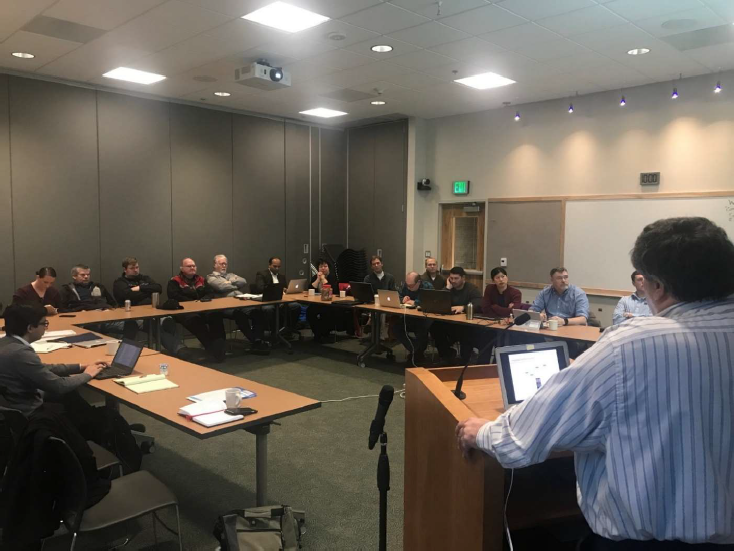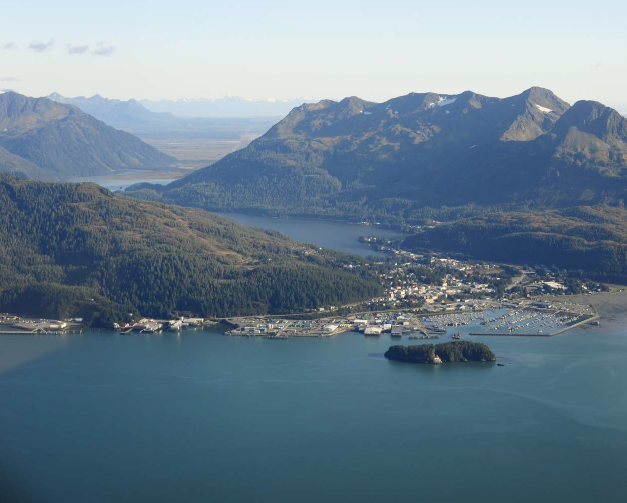
DOE GMLC Convening in Cordova

Rob Hovsapian, Idaho National Laboratory, Addresses the GMLC partners
Cordova, AK – Leading experts from the U.S. Department of Energy (DOE) met last week with various national laboratories and statewide associations at the Cordova Center in Cordova, Alaska to strategize the implementation of an innovative three-year microgrid modernization effort set to begin in Cordova in 2018 entitled “RADIANCE”. This project is anticipated to make significant advances to microgrid technology applications from the smallest rural Alaskan utilities to the continental American power grid. In Cordova, the project will build on the modeling, optimization, and installation of a grid scale battery that will liberate 500 kilowatts of currently wasted hydroelectricity (two supersize Walmarts or about 15% of Cordova’s average electricity use) at about one tenth the cost of developing new hydro. This and other value streams are projected to save over 100,000 gallons of diesel fuel annually in Cordova and improve power quality; a pioneering project propelled by the vision and leadership of Dr. Imre Gyuk, national energy storage expert and director of the DOE’s energy storage program.
DOE is invested in developing tools and technologies to establish a more resilient, secure, sustainable, and reliable electricity system across the nation and in September 2017 announced awards of up to $50 million to DOE’s National Laboratories to improve the resiliency of the nation’s critical energy infrastructure, including the electrical grid. “A resilient, reliable, and secure power grid is essential to the Nation’s security, economy, and the vital services that Americans depend on every day,” said Secretary of Energy Rick Perry. (DOE Press Release, September 2017.) This innovation effort at DOE has selected Cordova, Alaska as one of the premier locations to develop and implement new technology and Cordova Electric Cooperative (CEC) has found a new partner in executing their Smart City vision for the coming years. The four primary goals of this project are 1. Resilience; 2. Multiple networked microgrids; 3. Cybersecurity; 4. Field validation of resiliency enhancement methods.
“CEC is thrilled to partner with DOE’s National Laboratories and leading experts to upgrade and improve Cordova’s energy grid and resiliency,” said Clay Koplin, CEO of Cordova Electric Cooperative. “The improvements we implement throughout this partnership with the Department of Energy will not only improve the energy efficiency and security of the people of Cordova, it will benefit rural Alaskans who depend on isolated microgrid use and potentially all Americans; this is publicprivate partnership at its best.”
Alaska is a world leader in microgrids with an estimated 15% of the world’s hybrid microgrids and a leader in integrated technologies on those grids (Gwen Holdmann, ACEP). The night prior to the DOE meetings, Cordova experienced wind gusts up to 108 mph. The Cordova electrical system, however, did not experience outages due to past innovation of converting to 100% underground lines. This was a point of conversation at the meeting and an example of innovation that can be expanded upon in rural Alaska and the American grid in the future.
Participating partners convened at the Cordova meetings were as follows:
- Idaho National Laboratory, Leading Lab; Dr. Rob Hovsapian, project PI
- Pacific Northwest National Laboratory
- Alaska Center for Energy & Power
- Department of Energy
- Sandia National Laboratory, Dr. Abraham Ellis
- Alaska Village Electric Cooperative
- Washington State University
- New Mexico State University
- Florida State University
Additional points regarding the Grid Modernization Laboratory Consortium (GMLC) Grant:
- The project marries world class innovators (National Laboratories led by Idaho National Laboratory, Universities, and Global Equipment Manufacturers) with world class integrators (CEC, Alaska Village Electric Cooperative (AVEC) and the Alaska Center for Energy and Power (ACEP)).
- This is the largest GMLC grant awarded so far: $6.2M Dept. of Energy (DOE) with $1.5M match.
- The project aims to modernize the local Alaska microgrids and develop technologies to improve the resilience and security of the national grid, which will benefit the smallest villages in Alaska and larger grids across the nation.
- CEC, AVEC, and ACEP have built some of the most advanced grids in the world that provide a “living laboratory” in which to develop these new technologies.
- The GMLC will help to showcase the ARENA program, Arctic Remote Energy Network Academy, and ACEP which is drawing more and more international energy industry employees and students into an Alaska-led program to share our energy expertise worldwide. ACEP, CEC, and AVEC all have volunteer mentors in this program.
- Microgrid investments are expected to exceed $20B by the end of the decade, and represents a fantastic growth opportunity for Alaskan organizations with this expertise.
- The high visibility of this project will attract the attention of business partners and tech industry leaders to Cordova and other Alaskan communities.
- Improved technologies will likely grow the Alaskan footprint in this space and provide opportunities to advance such technologies as electric watercraft and aircraft.
This effort continues the Energy Department’s long history of public-private partnerships which work toward the energy sector’s Roadmap to Achieve Energy Delivery Systems Cybersecurity vision of resilient energy delivery systems. These systems are designed, installed, operated and maintained to survive a cyber incident while sustaining critical functions. Since 2010, DOE has invested more than $270 million in cybersecurity research, development, and demonstration projects that are led by industry, universities, and DOE’s National Laboratories.
In addition to undertaking the kickoff meeting last week with DOE, Cordova Electric Cooperative broke ground this week on installation of four free electric car charging stations at the Cordova Center in the center of the community. There are currently few, if any, public car charging stations in Anchorage; Alaska’s largest city of over 300,000, underscoring the innovation and progressivity of Cordova, a community of 2,300 year round residents. The City of Cordova is pressing innovation and renewables wherever possible, and has attracted international interest in their successful practices. Cordova hopes to lead the effort to move this conversation forward for many rural Alaskan communities and cities and partnering with the Department of Energy in this GMLC project will propel that effort into the future.
Cordova Electric Cooperative (CEC) is the sole provider of electric energy to the remote, coastal community of Cordova, Alaska. CEC owns and operates all power production and distribution facilities for the whole community. A small, nimble organization noted for creativity, innovation, talent, and achievement, CEC embraces the challenges of the energetic coastal environment in the North Pacific, and attracts the rugged, independent, success-oriented women and men that define the Cooperative.

Cordova Center, Site of GMLC “Radiance” Kickoff Meeting, Cordova, Alaska

Cordova, Alaska Aerial view of town and harbor


No Comments